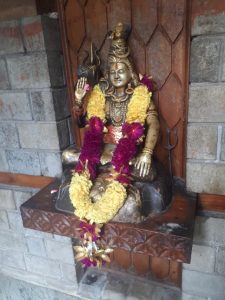Man-Manu-Manali
Manali is named after Manu. According to Britannica Online, Manu has the same root as “man” and “mentality”.
There are several variations to the story about Manu.
Trip Advisor says that Manu is a generic name, so there are different ones. The Manu here is Vaivasvata Manu – Vaivasvata being the son of the sun god Vivasvan (Surya), and a powerful rishi (sage).
Manu and the Big Deluge
According to Trip Advisor, during Pralaya, or dissolution of the Universe, the earth was drowned by a great deluge. Lord Vishnu, in his first avatar or incarnation as Matsya (the Fish), guided the ark of Manu to safety by tying Vasuki Naga (a mythologicl serpent) onto its horn. The boat was carrying, among other things, the seven great sages and the seed of creation. It was said to have moored in the Himalayas where Manali now stands. The name Manali is derived from ‘Manulaya’.
Tourmyindia.com says that “the temple… is believed to be the same place where sage Manu meditated after stepping on earth”.
Holidayiq.com has it that subsequent to the great flood, Manu, the ancient law-giver of India, landed at Manali and made the place his abode. He is said to have saved the Vedas and the seven sages from inundation during the great flood while in his seventh incarnation.
Britannica Online gives the most detailed information: Manu was the first man, and the legendary author of an important Sanskrit law code, the Manu-smriti (Laws of Manu). Manu was also the first man to perform sacrifice, according to the Vedas, and he was the first king.
Most rulers of medieval India traced their genealogy back to Manu, either through his son (the solar line) or through his daughter (the lunar line).
Noah and Adam in one…
According to Britannica, in the story of the great flood, Manu combines the characteristics of the Hebrew Biblical figures of Noah, who saved life from extinction in a great flood, and Adam, the first man.
The Shatapatha Brahmana describes how he was warned by a fish, to whom he had done a kindness, that a flood would destroy the whole of humanity. He therefore built a boat, as the fish advised. When the flood came, he tied this boat to the fish’s horn and was safely steered to a resting place on a mountaintop.
This Eve came out of the waters…
When the flood receded, Manu, the sole human survivor, performed a sacrifice, pouring oblations of butter and sour milk into the waters. After a year, a woman was born from the waters and announced herself as “Daughter of Manu.” The two then became the ancestors of a new human race to replenish the earth.
In the Mahabharata (“Great Epic of the Bharata Dynasty”), the fish is identified with the god Brahma, while in the Puranas (“Ancient Lore”) it is Matsya, the fish incarnation of Lord Vishnu.
The cycles never end
According to cosmological speculations of later Hinduism, a day in the life of Brahma is divided into 14 periods called manvantara, each of which lasts for 306,720,000 years. In every secondary cycle the world is re-created, and a new Manu appears to become the father of the next human race. The present age is considered the seventh Manu cycle.
Small but mighty important
To summarize, this small temple is really iconic and special, and should be given more importance than it seems to get, but this is how Hinduism works. The current structure – a result of several renovations – is the only temple dedicated to Manu on Earth... Brahma, the Creator, also has to make do with one temple, the one in Pushkar, while Vishnu, the Maintainer and Shiva, the Destroyer have temples in every Hindu city…
At any rate, the humbleness of this temple only adds to the sense of mystery surrounding it, and is definitely worth your visit while in Manali – the town of Man.
Onwards to Vashisht
The next day I went to Vashisht by myself.









This Post Has 0 Comments